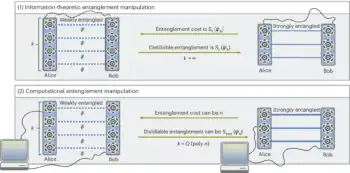The spin state of a single electron in a quantum dot has been measured for the first time without destroying the state. David Awschalom and colleagues at University of California, Santa Barbara, determined the spin by reflecting polarized laser light from a quantum dot. The development could lead to the exploitation of the quantum properties of single electrons in quantum computers (Sciencexpress 9 November 2006).
Quantum computers could exploit the fact that a quantum particle can be in two states at the same time – spin up or spin down in the case of an electron. With the two states representing a one or a zero, N such particles – or quantum bits (qubits) – could be combined or “entangled” to represent 2N values simultaneously. This could lead to the parallel processing of information on a massive scale. However, the realization of a quantum computer involves fundamental challenges such as how to read the logical state of a qubit without destroying the state, and how to entangle the qubits.
Semiconductor quantum dots are nanoscale structures that contain as few as one electron and show great promise for use as qubits. Information can be stored in the spin state of a single electron and while several optical and electronic schemes exist for reading the spin state, they all destroy the state as part of the process.
The Santa Barbara group shone plane-polarized laser light on a gallium-arsenide quantum dot. The spin state of the electron was determined from the direction of rotation of the polarization of the reflected light – the so-called Kerr rotation. According to Awschalom, a Kerr rotation measurement is inherently non-destructive because it involves photons that have reflected from the sample without absorption. “If a photon was absorbed by the dot (thereby disturbing the system), then Kerr rotation would not be observed”, he explained. The researchers minimized the chances of absorption occurring by using photons with energy sufficiently far from any optical transitions in the quantum dot.
Awschalom explained that the Santa Barbara work represents an important step towards the optical entanglement of single-electron quantum dots. Upon reflection, photon and dot are entangled in the same quantum state. If the photon is then reflected from a second dot, all three are entangled. If the polarization of the photon is then measured, the two quantum dots remain entangled.


